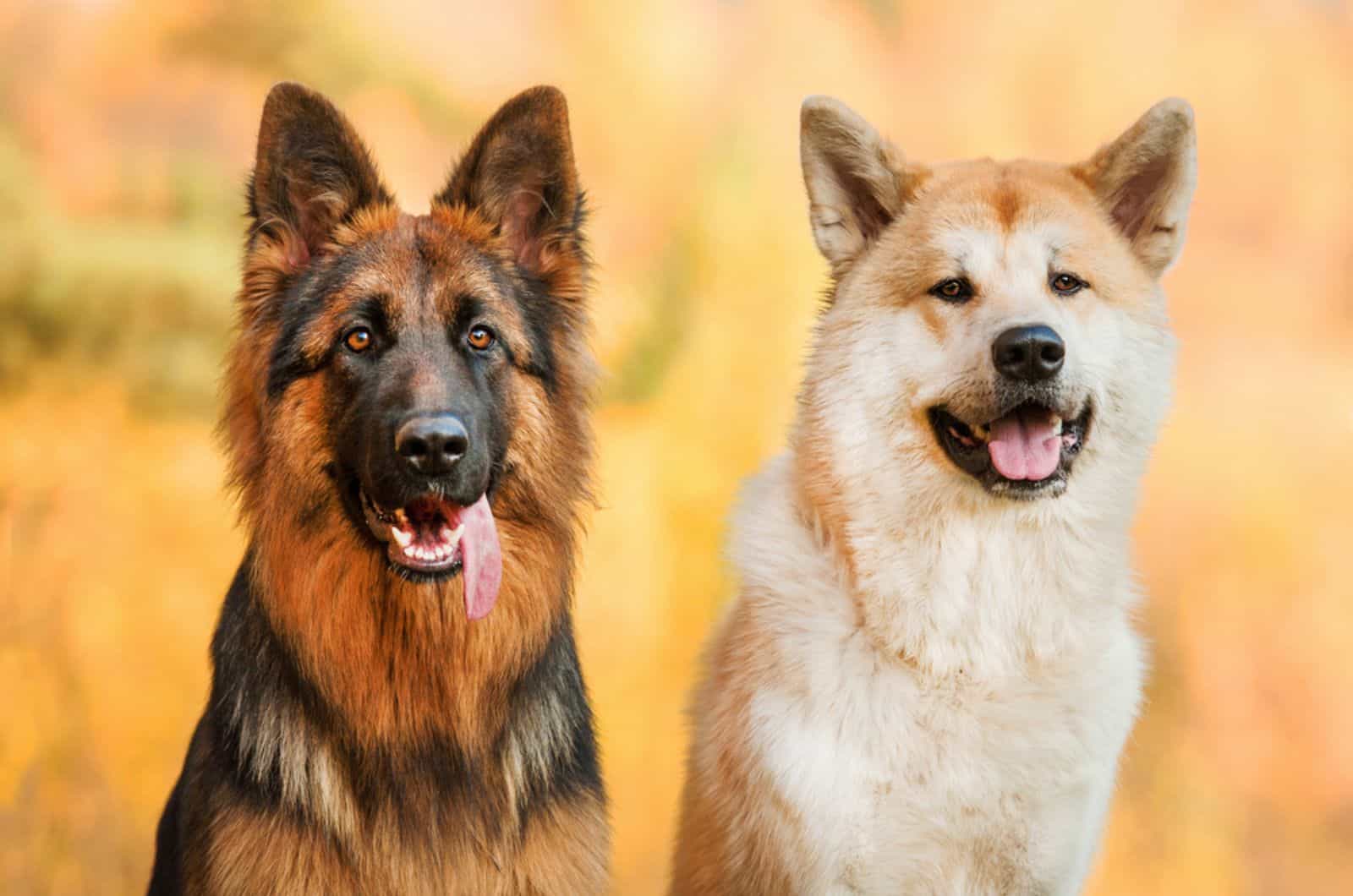Even though the German Shepherd Akita mix dates back to the 1900s, this designer dog is quite hard to come across on the street or in a dog park. The reason behind this lies in the fact that Akita puppies are rare in comparison to other puppies.
In fact, these purebred dogs haven’t been as affordable in the 20th century as other dog breeds as they were expensive, and owned only by wealthy people.
However, the Akita Shepherd puppy is an extremely intelligent guard dog that collects only the best traits of both the GSD and the Akita Inu. Still, the breed is not for first-time dog owners as these canines can be too much at times.
In order to have a good, reliable Shepkita as your companion, you need to take into consideration the breed’s history, temperament, and daily exercise needs. But first, let’s see what these great dogs are really about!
What Is A German Shepherd Akita Mix?
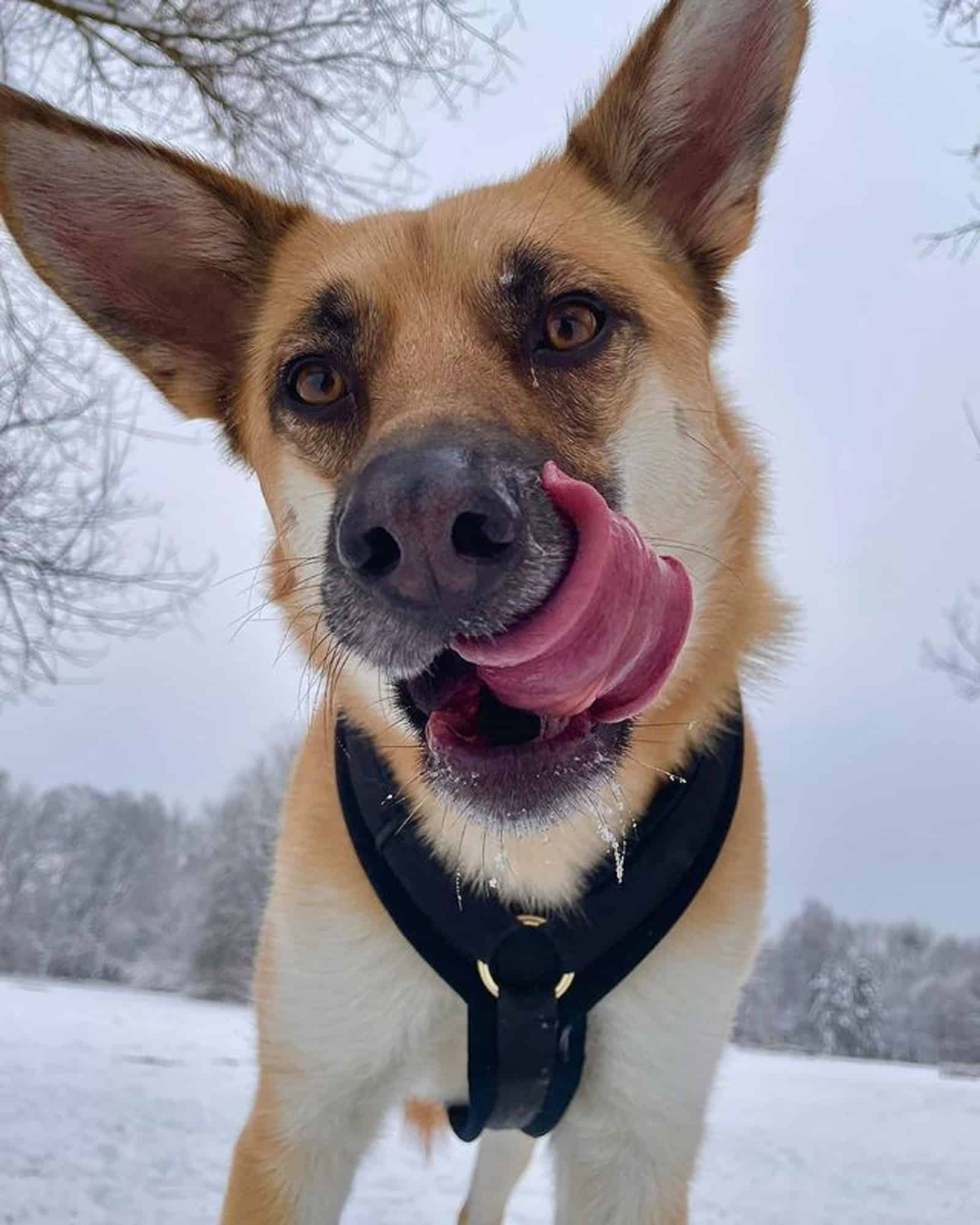
As the name says… the German Shepherd Akita mix is a crossbreed between two very dominant, yet loyal dogs – a German Shepherd and an Akita Inu (‘‘Inu’’ is the Japanese word for ‘‘dog’’).
These canines have been among American families since the 1900s as Akita puppies arrived in the United States in the mid-1900s. The Japanese Akita was officially recognized by the American Kennel Club in 1972.
Nowadays, many people mix Japanese and American Akita puppies. However, there is a significant difference between these two pooches as Japanese puppies are known for their brindle, red, and black coat color pattern, while the American Akita comes in various brown shades.
The Shepkita puppy makes an excellent guardian with an exquisite prey drive. Due to their GS bloodline, these canines can be excellent working dogs, too. The breed is known to be loyal and affectionate to their owner, although this puppy requires early socialization.
Many Akita mixes are known for their high-maintenance nature as these dogs can be fastidious and intolerant at times. Still, with proper training and a committed owner, the Shepkita puppy makes a decent pet.
Meet The Parent Breeds
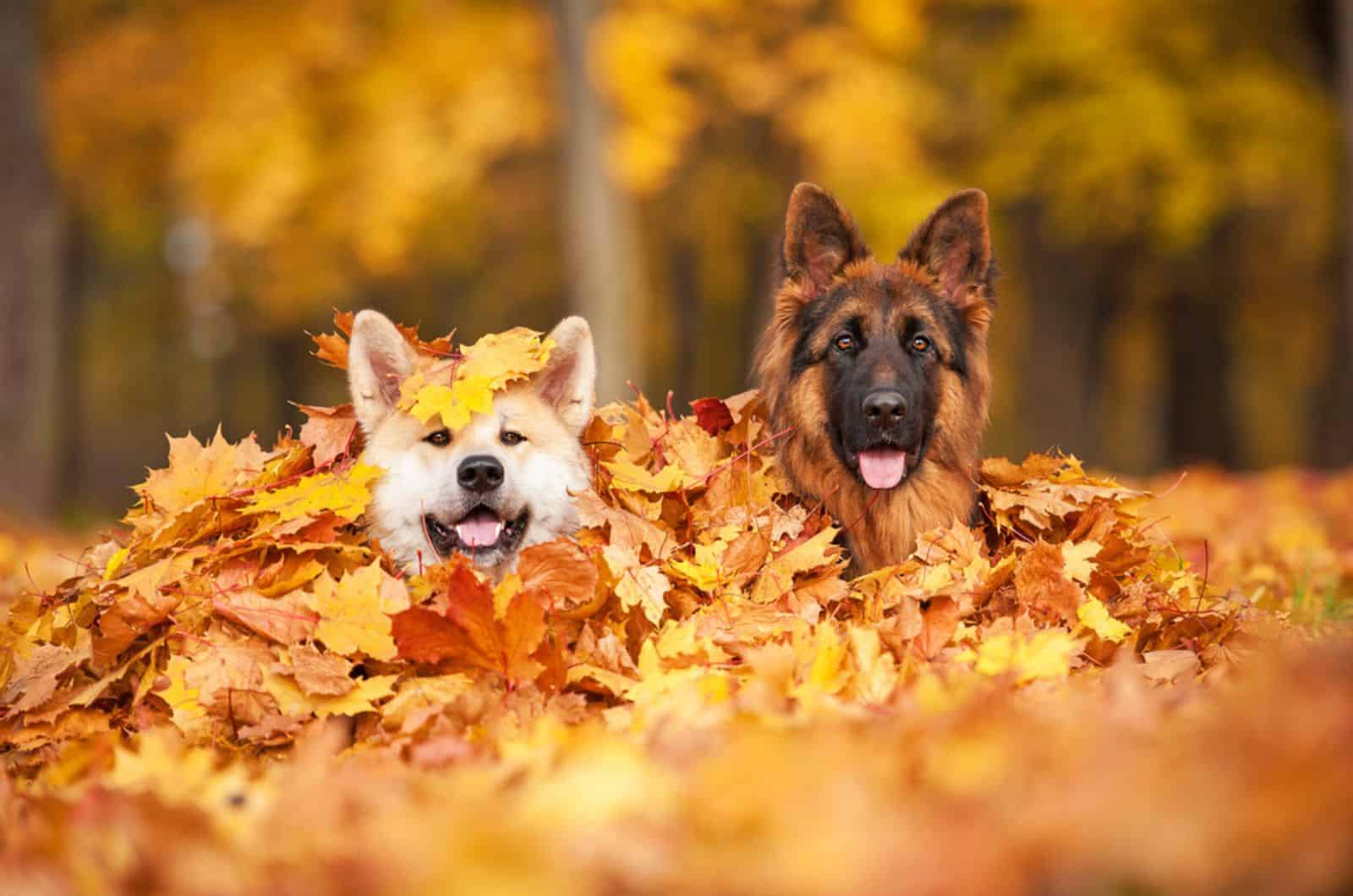
If we assume that the history of the Shepkita puppy is still pretty vague, the best way to get to know this puppy is if we meet its parent breeds first.
Both Akitas and German Shepherd dogs are known for their vigilant, independent, and brave temperament, which makes this puppy a great watchdog.
Furthermore, these canines have a long history of serving families, which makes these large dogs loyal, affectionate, and true companions.
However, in order to have a reliable puppy in your home, you need to make sure to buy it only from a reputable breeder. This especially goes for Akita dogs as these canines require a careful, high-quality breeding program.
Reputable Akita breeders will make sure you get early socialized, well-behaved, and bloodline-tested Akita dogs, which is a must for a decent pet. The same goes for the GSD as these canines can be aggressive if not timely socialized.
Given their occasional aggressiveness and high prey-drive, both of these dogs require a patient, committed, and experienced owner, which is exactly why Shepkitas are not recommended for novice owners.
German Shepherd
GS dogs are probably one of the most popular dog breeds in the world. Their exquisite temperament and high intelligence put this breed on top of the list of the most favorable family pets ever.
This puppy comes from Germany, where it initially served as a herding dog. Nowadays, the breed is known to be a family dog, as well as a military and law-enforcement dog.
When it comes to their size, these pooches are 65 to 90 pounds heavy, and their height revolves between 24 and 26 inches on average. In order to have a full-blooded GSD in your house, make sure to buy it from a reliable breeder only.
Certified, reputable breeders subject their GS puppies to DNA tests, as well as health tests, which is a must for a healthy and reliable GSD.
These canines, although qualified among the healthiest dogs in the world, face several major issues such as hip dysplasia, bloat, degenerative myelopathy, and pancreatic insufficiency.
These canines have a medium-sized, double coat, with black and cream, black and tan, black and red, blue, gray, sable, liver, and black color patterns. They require brushing once or twice a week as they are moderate to high shedders.
When it comes to their training, these canines require early socialization and regular mental stimulation. Every GS owner should be aware of the fact that these dogs are highly intelligent, which makes them get bored easily.
They require new ways of entertainment, which will make them occupied and mentally stimulated. Consistent training as well as regular exercise are the keys for a mentally-healthy GS puppy. These large dogs have high exercise needs. With that being said, your GS dog will need at least two hours of training on a daily basis.
These canines are perfect walking, hiking, and jogging companions. Given their high intuition and intelligence, they make excellent nannies, too.
Akita Inu
Coming from distant Japan, these purebred puppies have a long history of being among families as hunting dogs. These puppies are a Japanese national treasure, as they represent a symbol of longevity and happiness.
Given their hunting nature, these puppies are not ideal for families with small children. At times, Akita puppies can be extremely dangerous dogs as their tolerance level is not that high.
When defining an Akita’s growth chart, we should know that these puppies qualify among large dogs, which makes them even bigger than Huskies and other dogs from the Spitz family. They are 26 to 28 inches tall, while their weight revolves between 100 and 130 pounds on average.
Just like their GS counterparts, these canines have a medium-long, double coat, which requires frequent grooming. If you are a proud Akita or Akita Shepherd owner, the use of a slicker brush will be at least a weekly ritual in your house.
The American Kennel Club recognizes several color patterns in Akita puppies: black, brown brindle, fawn, red, white, brown and black overlay, red and black overlay, fawn and black overlay, and lastly… silver and black overlay.
Given their exquisite, fashionable fur, Akita puppies qualify among the prettiest dogs in the world. However, these canines don’t make the best dogs when it comes to families as they are intolerant of other pets, and their relationship with small children is poor.
At times, these highly intelligent puppies can be fastidious and mischievous. However, early-socialized and obedience-trained puppies make decent family dogs.
The German Shepherd Akita Mix’s History
The exact birth date of the German Shepherd Akita mix is still vague. However, according to professionals, this puppy entered the U.S. in the mid 1900s, just around the time when the AKC recognized Akita puppies as an official breed.
The best way to take a peek into the history of these mixed breed dogs is if we look into their ancestry. Both male and female Akita puppies are a national treasure of Japan as they represent symbols of happiness and longevity.
These purebred Spitz dogs have a history of being hunting dogs and watchdogs as they are vigilant and always on alert.
On the other hand, GS dogs have been herding dogs in Germany since the 1800s. They have the natural instinct of a guardian, which makes them excellent protection dogs, as well as police and military dogs.
Although the breed was originally bred for herding and protecting flocks, GSDs are nowadays decent family dogs that get along well with all family members.
Shepkita’s Appearance
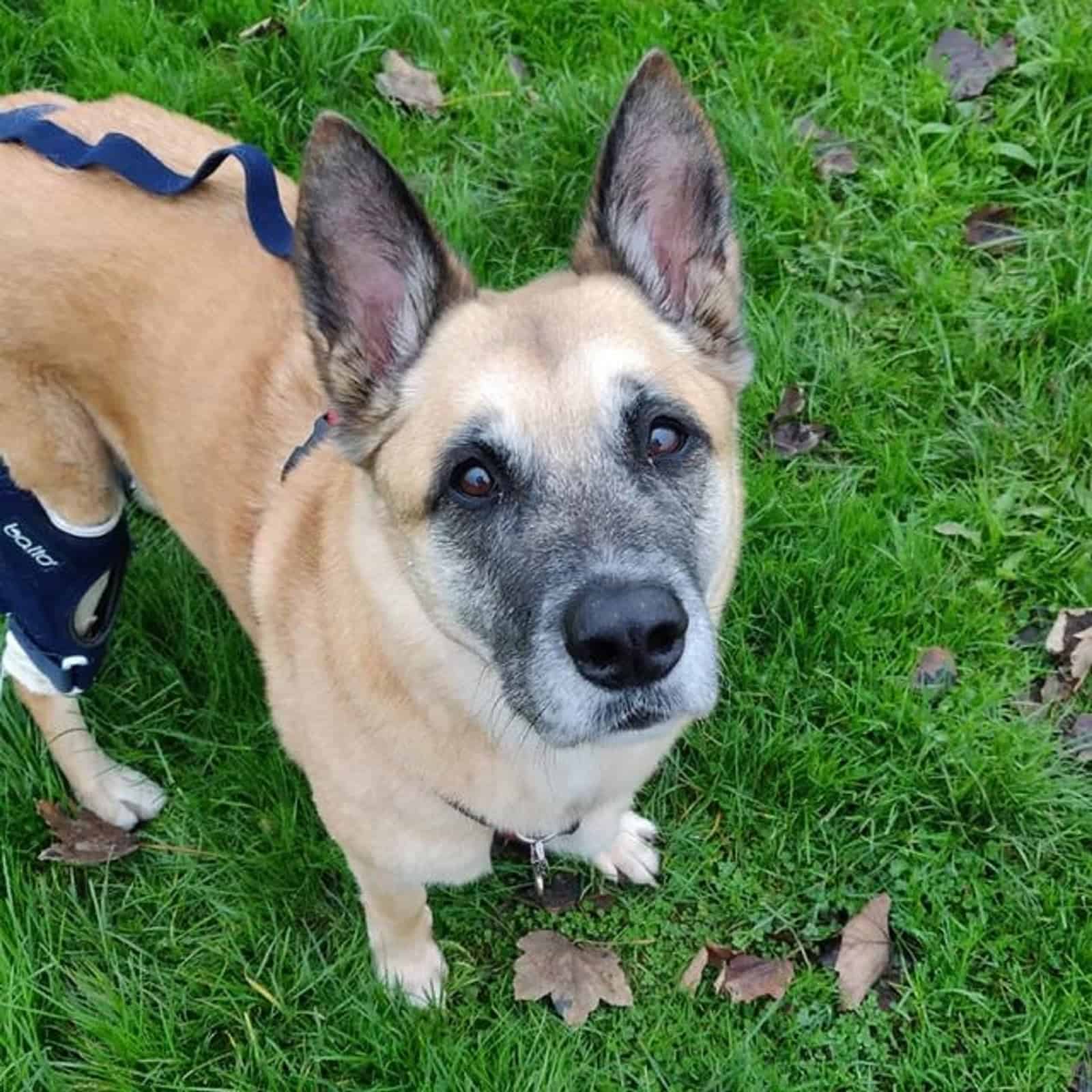
When it comes to their physical appearance, Shepkita puppies have the body of their GS parent and the face of the Akita. Still, depending on the bloodline, some Shepkita puppies can have long, pointy GSD ears.
These canines are muscular, and they are covered with a medium-long, double coat. They have strong legs that make them active, agile, and high-energy. Their broad chest makes them prone to stomach torsion, which is why it is not that smart to overfeed your Shepkita puppy.
These dogs are generally smaller than their Akita parents as they have a slightly smaller head, and a body that resembles the GS dog. Their snout is shorter than in GSDs, while their eyes have a brown color pattern and an almond shape.
Given their body physique, these canines have high exercise requirements as they need to burn off their energy for at least one to two hours every day. The breed is not as active or as strong as Pit Bulls or Dobermans, but they are perfectly capable of defending their property and family.
All Shepkita puppies have a strong bite and a determined temperament. However, some puppies can have a longer coat, which makes them look less athletic.
These canines belong to the large-breed dog club as they are up to 110 pounds in weight.
Size
Generally, the average weight of a Shepkita puppy revolves between 75 and 110 pounds, which makes this dog slightly bigger than its GS parent. On the other hand, all Shepkita dogs stand between 24 and 26 inches in height.
This is a large dog, which is what you need to take into consideration when buying it. The breed doesn’t do well in small apartments or studios. On the contrary, these puppies need plenty of space and a fenced back yard.
In order to keep it in shape, you should take care of its feeding chart and its exercise requirements. Its feeding chart positively correlates with its GS parent’s feeding chart.
However, you should bear in mind that GS puppies have a tendency of gaining weight pretty easily, which is inherited by the Shepkita dog, too.
Avoid table scraps and junk food as they can be a trigger for a stomach torsion in your puppy. Furthermore, obese Shepkita dogs are more likely to get diabetes and heart disease.
If your dog is suffering from hip or elbow dysplasia, obesity can worsen these conditions, and cause extreme pain in your dog’s front and hind legs.
Coat Type And Coat Color
Generally, these hybrid canines have a medium-long coat that sheds moderately. The breed requires brushing with a slicker brush at least one or two times a week. On the other hand, these puppies can be bathed every few months or so.
Their bathing depends on the intensity of their outdoor activity.
The recommendation to future owners is to subject your puppy to early crate training. This way, your puppy will get used to one sleeping place easily, which will save you from additional cleaning and collecting hair trails all over the house.
If you or your family members suffer from severe dog allergies, the advice is to look for a hypoallergenic dog breed as these pooches leave hair trails anywhere. Pooches like Poodles and Bichon Frises are perfect in this regard.
When it comes to their coat color, Shepkita canines can come in both GS and Akita color variants. The most popular colors in these hybrid dogs are sable, brindle, black and tan, merle, black and cream, white, and brown.
These puppies, just like their Akita parents, make quite fashionable dogs in their appearance.
They have the GS eye color pattern as most Shepkita puppies come with brown eyes.
Temperament Of The German Shepherd Akita Mix
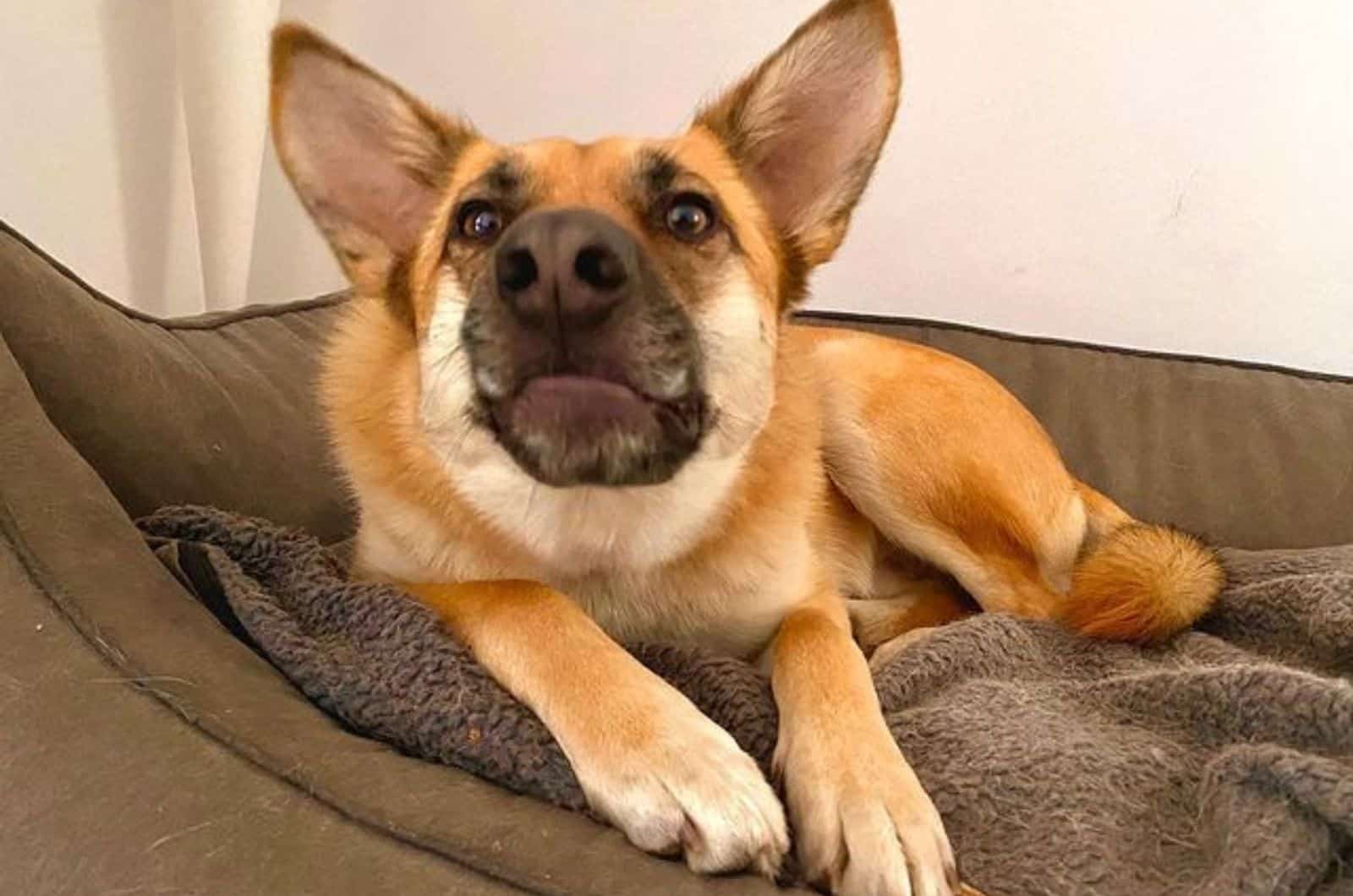
Unlike some small dog breeds, the temperament of the German Shepherd Akita mix is not subject to frequent changes and outbursts. These canines are rather calm, quiet, and self-confident.
However, the Shepkita puppy can be extremely stubborn and fastidious. Just like their Japanese parents, these canines need early socialization and obedience training. Otherwise, you will face a potentially aggressive dog, especially towards strangers and other pets.
‘‘How to socialize an aggressive dog’’ can be an impossible mission for an owner of an untrained Shepkita puppy.
Still, Shepkita dogs are far easier to train and to adapt in comparison to their purebred Akita parents. Their GSD bloodline makes them loyal, obedient, and well-behaved by nature, which makes the overall training easier.
In order to burn off their high energy, Shepkita puppies need longer training sessions in respect to other family dogs. Engaging them in long walks, hikes, and jogging is always a smart choice as these puppies enjoy activity of any kind.
However, you cannot neglect their mental stimulation needs as mental training is as equally important for Shekpitas as physical training. These puppies have a bloodline of two extremely intelligent dog breeds, which makes them get bored easily.
Mental stimulation games are perfect for keeping your puppy entertained.
Given their high-maintenance character, these pooches are perfect for owners who know how to raise them. Unlike other family dogs, they are not recommended for novice owners nor for people with a busy schedule.
Socialization
Unlike their GS parents, Shepkita puppies may be more overwhelming in terms of their socialization process.
Generally, GS puppies are good with cats and other pets once they are socialized. Unfortunately, that’s not always the case with their Shepkita offspring as these hybrid dogs have a low tolerance for other family pets.
That’s why it is important to start socializing your dog as soon as possible. Try bringing as many people as possible to your house during the Shepkita’s young age. That way, your dog will learn the difference between an enemy and a welcomed stranger in your home.
Additionally, you can always try using training supplements, such as training collars, or interactive dog toys. Positive reinforcement techniques such as praising, petting, and giving your dog healthy snacks can be a plus in this regard.
However, you need to make sure that your dog sees you as the pack leader. Otherwise, you will have a long-term problem that you cannot resolve without engaging a professional dog trainer.
Aggressiveness
Both of the Shepkita’s parents belong to the club of aggressive dog breeds. They are natural watchdogs as they have a high prey-drive and the need to defend, protect, and guard.
There is a high possibility that your Shepkita puppy will have the same traits by default. That’s why it is highly important to subject your pet to early socialization training.
Teaching your dog how to differentiate between enemies and friends is the key to a good and reliable family dog in the future.
However, there are several situations in which your Shepkita puppy might have behavioral outbursts.
For starters, you should know that these pooches are highly attached to their owner. With that being said, there is a high possibility of the Shepkita suffering from severe separation anxiety.
Separation anxiety in dogs positively correlates with their self-destructive behavior. That’s why it is not recommended to buy these puppies if you have a busy schedule, or if you are always away.
Furthermore, the breed can display aggression as a result of improper parenting. Not knowing how to parent your Shepkita dog may be a massive problem as these pooches negatively respond to yelling, punching, or neglecting their needs.
Other than that, early-socialized Shepkita puppies are not likely to display aggressiveness as they are well-behaved, obedient, and calm.
Trainability
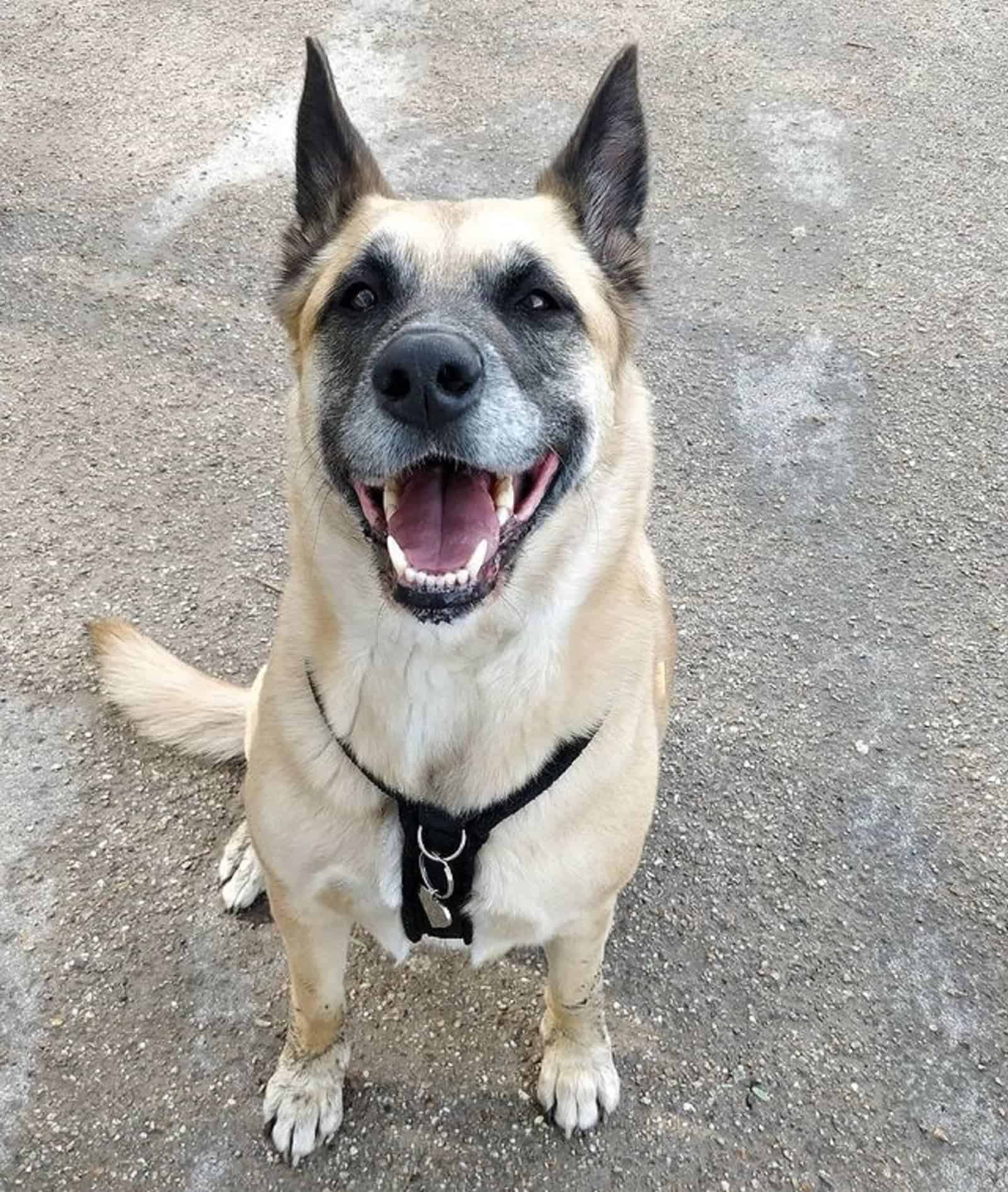
If you are an experienced dog owner, then the training process of your German Shepherd Akita mix will be a true pleasure. These pooches, just like their purebred parents, are known for their exquisite intelligence and intuition.
GS puppies are generally easy dogs to potty train, socialize, and teach obedience. However, Akita puppies may be slower in the overall process as they sometimes display mischievous and stubborn behavior.
Still, training these puppies won’t be a problem as long as you start from an early age. Early socialization and obedience training are the keys to a good Shepkita pet.
Furthermore, take into consideration your puppy’s daily exercise requirements. This breed needs at least one to two hours of exercise on a daily basis. With that being said, try taking your Shekpita puppy out for a walk at least two times a day.
If you don’t have the luxury to go out twice a day, then try creating an entertainment center out of your back yard for your dog. These pooches love stimulating playgrounds, which is why building an agility playground would be heaven for your Shepkita.
Housing
While GS puppies make one of the greatest family dogs in the world, Akita puppies can be reserved and high-maintenance at times.
Furthermore, these Japanese Spitz puppies don’t do well with small children and other house pets, which is why you should look for another dog if you have kids or pets in your family.
Luckily, the German Shepherd Akita mix has a high potential of being a good family addition. Due to a good part of their GS bloodline, these canines make decent friends with children as long as they are regularly supervised.
On the other hand, Shepkita puppies embrace new things easily as they have a high level of intelligence. They will quickly learn all the dos and don’ts in your home, which is why these canines are favorable for keeping indoors.
Still, if you live in a studio apartment, you should probably give some other breeds a try instead of this one as Shepkita dogs are large, and they require plenty of space. These pooches are rather recommended for families who live in the countryside and have plenty of space in their back yard.
Teaching your Shepkita puppy how to use a potty, or getting it used to its dog bed would not be a problem as these pooches adapt easily. However, if you have other pets in your house, make sure you start socializing your dog from its puppyhood stage.
Shepkita’s Health Problems
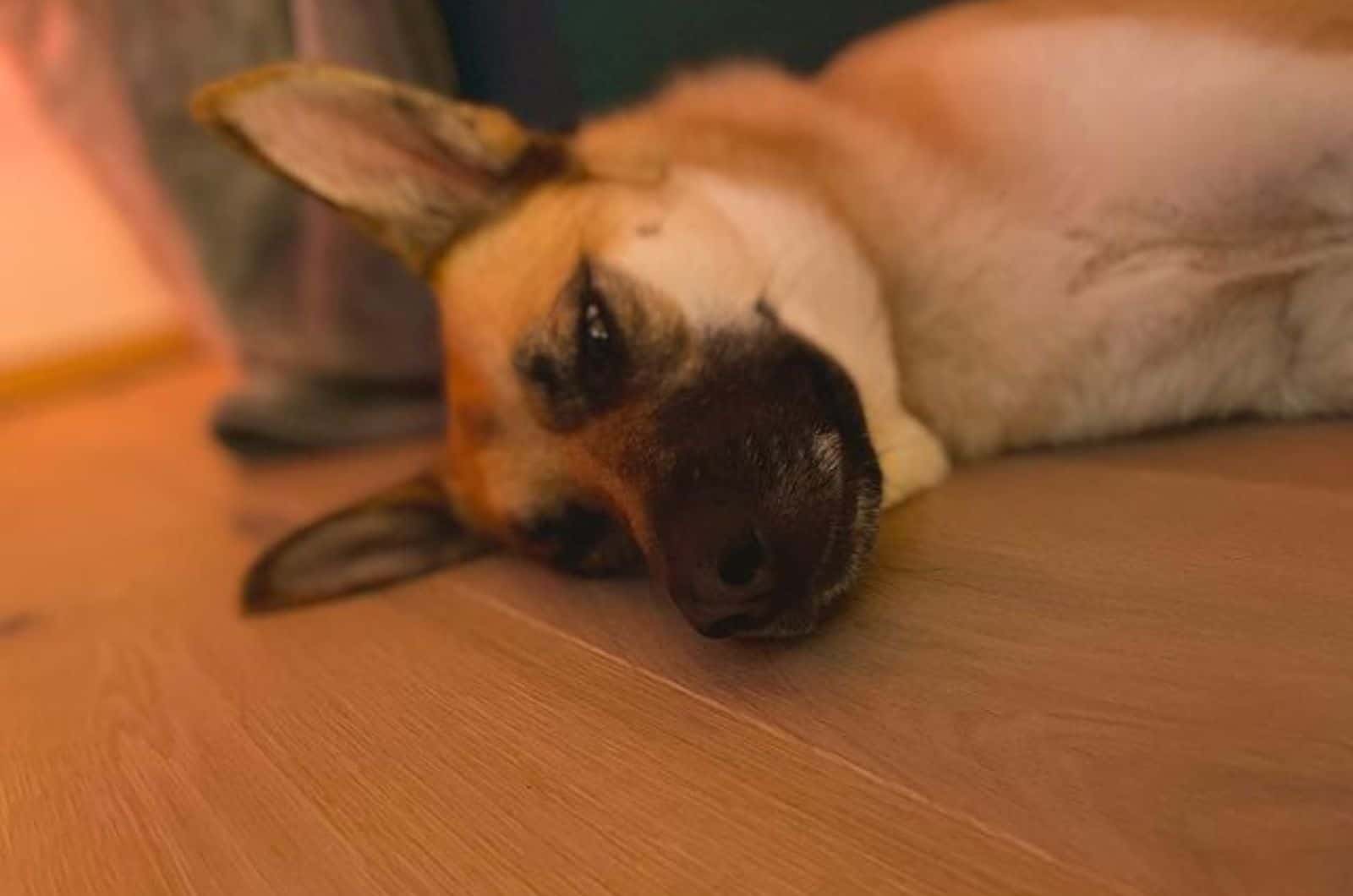
We can say that the German Shepherd Akita mix is a quite healthy dog, considering that it comes from two extremely healthy dog breeds. In fact, GS puppies are known to be among the twenty two healthiest dog breeds in the world.
Still, the offspring can face several major health issues such as hip dysplasia, bloat, progressive retinal atrophy, and autoimmune thyroiditis. Some dogs even face hemophilia and Von Willebrand’s disease, which is rare.
Other than that, these pooches live a happy and long life. In order to keep them healthy, you need to take into consideration their daily exercise needs as well as their feeding needs.
1. Hip Dysplasia
Hip dysplasia in dogs is common for large dogs, and the condition is mostly hereditary. It is related both to GS and Akita puppies, which puts the Shepkita puppy in an unenviable position.
This condition is characterized by hip loosening, which causes pain in the hind legs, along with several other symptoms such as bunny walk, pain in the groin, limping, reluctance to climb up or down stairs, lethargy, and lack of activity.
This condition should be treated as soon as the first symptoms are noticed as untreated hip dysplasia can be a trigger for further injuries.
In order to avoid hip dysplasia in a dog, always make sure to buy the puppy from a reputable breeder. High-quality breeders generally subject their newborn puppies to hip and elbow dysplasia evaluation, which makes it hard to sell you a puppy with this condition.
Still, if you have a canine with hip dysplasia – be at ease! This condition is not fatal as puppies that have it can live a long, normal life.
The ultimate treatment of hip dysplasia in dogs is surgery. However, the average cost of this procedure revolves between $1500 and $3000, which is not that cheap.
2. Bloat
Unlike hip dysplasia, bloat in dogs can have deadly repercussions if not treated timely. This condition is generally related to large dogs with a wide chest, which is the case with the German Shepherd Akita mix.
The most common symptoms of bloat are lack of appetite, lethargy, restlessness, panting, heavy breathing, a swollen stomach, and a stomachache. Some dogs with bloat even refuse to drink water.
This problem is rooted in improper feeding as well as in poor-quality dog foods. That’s why you should avoid table scraps and junk food at all times. Furthermore, preparing a well-organized feeding chart for your Shepkita would be a plus.
If your dog has a tendency of being affected with bloat, try dividing its meals into at least three smaller ones. That way, you will avoid voracious eating in your dog, and consequently – bloat.
Another tip that we can give you is to avoid feeding your canine right before bedtime. Unprocessed food does as much damage to your canine as junk food.
3. Progressive Retinal Atrophy
Progressive retinal atrophy in dogs, unfortunately, represents gradual but unavoidable blindness. However, the blindness doesn’t always have to be total as some puppies with PRA experience partial blindness.
This is a hereditary issue that affects the photoreceptor cells in a dogs’ eyes.
This condition is not curable, which is why if you have a dog with PRA, you should learn how to adapt your puppy to new circumstances.
For starters, keep your canine away from sharp edges as it may hurt itself. Puppies with PRA, despite their excellent sense of smell, can lose coordination at times.
Furthermore, avoid surprises, and always try approaching your dog from the front. That way, you will avoid unpleasant outbursts in your dog’s behavior. Most of the time, behavioral outbursts are triggered by the fear of the unknown.
4. Autoimmune Thyroiditis
Autoimmune thyroiditis is one of the thyroid diseases in dogs. The condition itself represents the immune system attacking the thyroid gland and causing hypothyroidism.
However, this condition doesn’t necessarily need to be a thyroid problem as it can also be a symptom of some other disease, such as panendocrinopathy.
Some of the symptoms related to this autoimmune disease are lethargy, weight gain, changes in the dog’s skin, cold intolerance, confusion and dullness, as well as exercise intolerance.
Unfortunately, this condition cannot be completely cured. However, some medications can regulate hormone levels as they replace hormones and regulate the dog’s metabolism.
The Shepkita’s Price
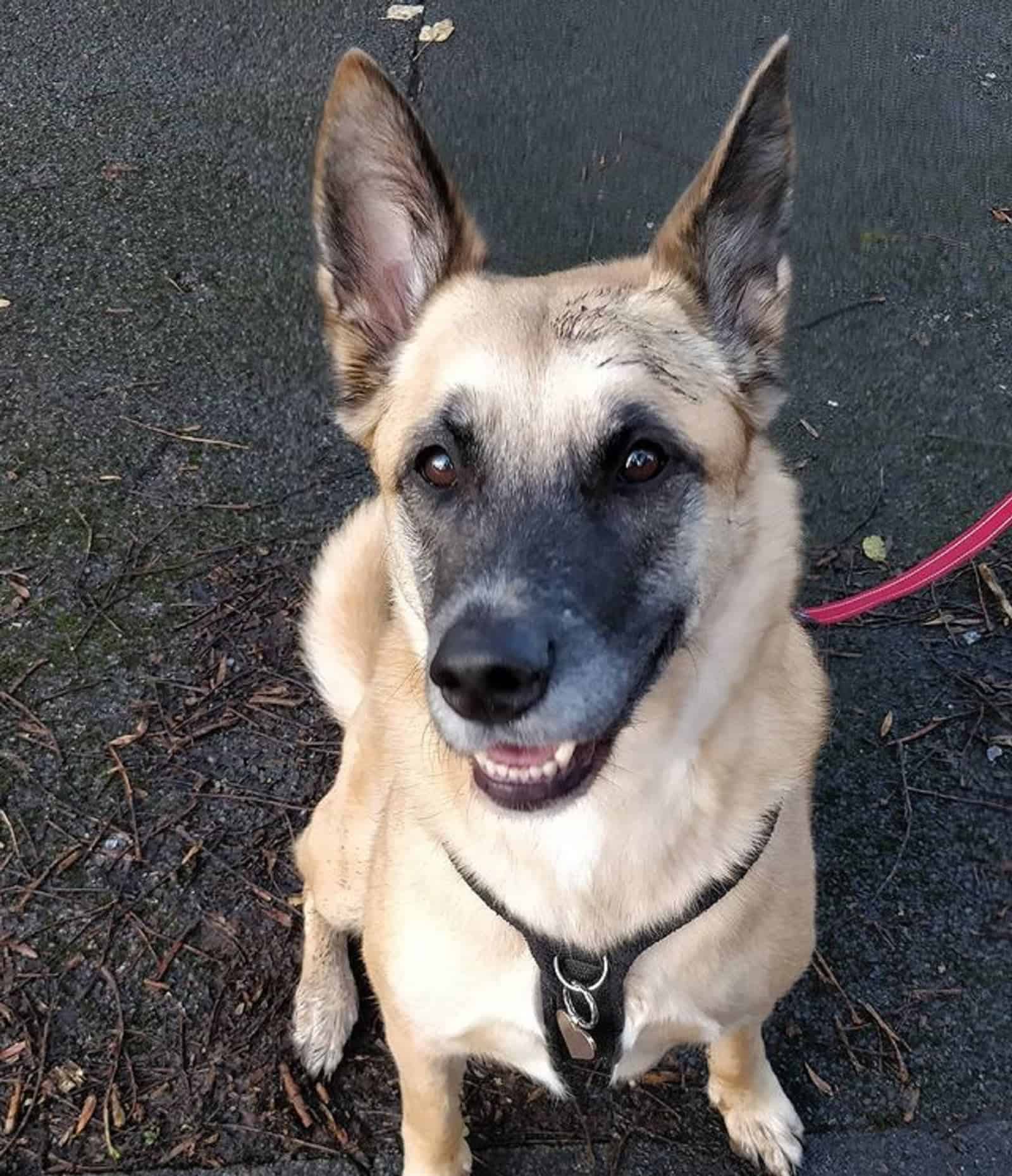
Generally, these crossbred canines cost between $1000 and $2000. However, their price depends on several factors such as age, sex, coat type, coat color, and the reputability of the breeder.
Puppies at reputable breeders often cost more as several additional segments are included in the price: health exams, vaccinations and deworming, bloodline tests, the adaptation to food, a blanket, dog toys, a leash, dog training collars, a microchip, and 24/7 service for new owners.
The advice is to always choose reputable breeders over shady puppy mills. The puppy’s price at the latter can be lower in the start, but it may cost you more in the future.
On the contrary, getting a dog from a long-term, reliable breeder will mean that you will be getting a healthy puppy that won’t require as much healthcare as their unreliable counterparts.
FAQs
Shepkita puppies can be great family dogs once they undergo early socialization and obedience training. Just like their parent breeds, these canines need proper upbringing, which includes socialization with family members, children, and other pets.
Choosing the best breeder for your Shepkita is as equally important as choosing the best Akita and GSD breeders.
Untrained Shepkitas, or improper Shepkita parenting can be a precursor for an aggressive dog in the future. These canines come from two aggressive breeds, which is why these dogs are not recommended for inexperienced dog owners in the first place.
These hybrid dogs generally weigh between 75 and 110 pounds, and their average height revolves between 24 and 26 inches. The growth chart of a Shepkita puppy resembles the growth chart of a GSD.
The breed is closer to their GS parent in terms of their size as Shepkitas are significantly smaller than their Akita parent.
Final Thoughts
The German Shepherd Akita mix is a rare hybrid puppy that adapts well into family life. Still, this designer dog is not recommended for a novice owner as Shepkitas seek an experienced, firm, and knowledgeable owner.
Once they are socialized – Shepkitas make excellent family additions as they are loyal, affectionate, and eager to protect. However, if you live in a small apartment, or in a studio, the best choice is to look for another, smaller breed that will adapt to apartment life easier.
These canines require plenty of space, which is why the countryside is probably the best environment for these Japanese-German champions.
